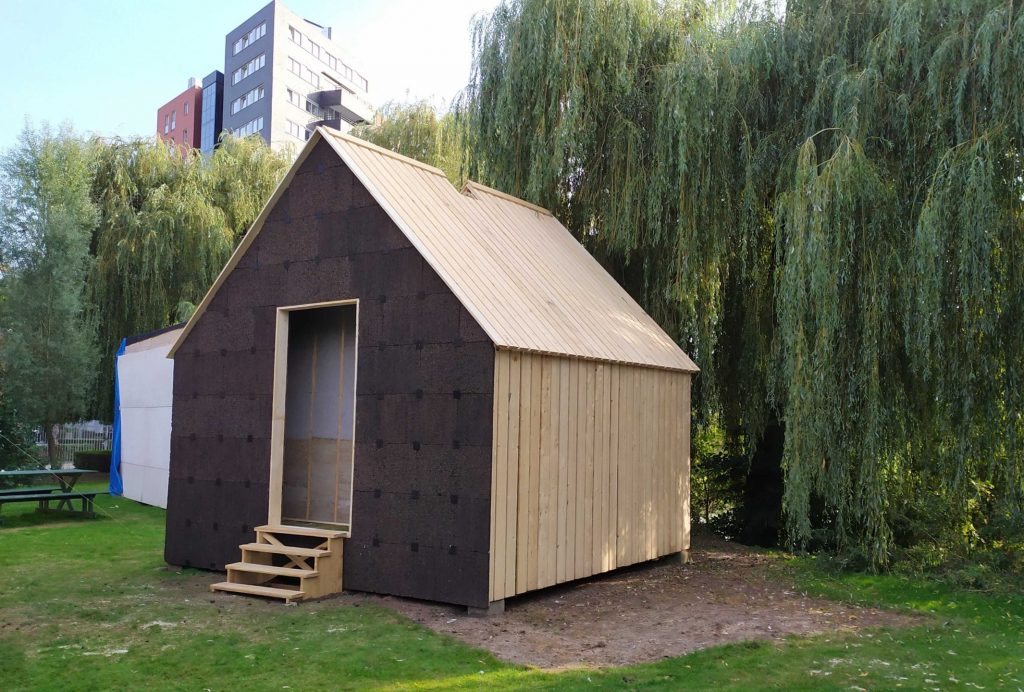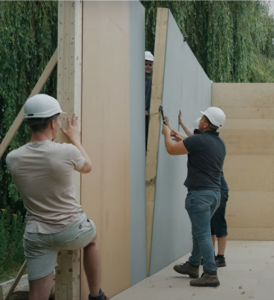
Two biobased buildings made by students and researchers, you can find them in the backyard of Avans in den Bosch. A beautiful place where students of, among others, the academy for Building & Infrastructure and researchers of the Biobased Building lectorate work together on innovation. Companies are often involved in these projects as well. This means that the knowledge actually ends up in the business world. On the other hand, students are prepared to put biobased construction into practice after their studies. And that is exactly what this place is meant for. The aim is to fill the entire field with circular and biobased objects.
In addition to the large backyard where several structures are located, there are also projects that take place inside. There is a lot of collaboration with the other location where the lectorate Biobased Building is active, namely the SPARK Makerszone. This is actually the breeding ground for most of the projects that can be seen at Avans Den Bosch. We have listed the most recent projects for you.
BIOBASED REFLECTION HOUSE
Building a house with little experience and with people you don’t know? And what about using biobased materials, which are often new and unknown? This task was given to the 39 students who recently started the minor in CO² negative design. They delivered a very nice performance, which not only creates a strong team spirit, but is also a fine example of how research and education come together. Iwan Westerveen, researcher in the lectorate Biobased Building and lecturer of the minor, explains: “The idea is that students get to know each other and biobased materials. They learn right away in practice how they can handle these materials and where the challenges lie.” So something actually has to be built, and in this case a bio-based ‘reflection space’. Its design comes from a former student, who previously attended the minor. The reflection space is now there, and has been officially opened in the presence of all those involved. From now on, improvements can now be made by current and future students, so that the cottage can continue to exist and be continuously improved over the years.
CBCI UNIT
The European subsidized project CBCI investigates how we can use raw materials in construction more efficiently, in order to reduce CO² emissions, during the entire life cycle of a building. For the transition to a circular economy, an integrated approach for circular and biobased construction is developed, which forms the basis for the construction sector. As part of this project, a multidisciplinary team of the students went to work on a 100% biobased circular unit. In 9 weeks, the students came up with different biobased applications, tested them and made prototypes. This resulted in the CBCI-unit that you can see at Avans Den Bosch. The findings made by the researchers and students during the design and construction also come directly to the business partners in the project through the CBCI project.
CLIMATE ROOMS
Soon there will be even more to see at the Biobased Building Construction Site. Two shipping containers will be installed as part of the Bio Iso project that will function as climate chambers. The containers are equipped with installations that can simulate day and night and can both freeze and heat. The test set-up is intended to allow full-scale testing of biobased and circular façade elements under different conditions in order to subsequently observe the differences. In this way, insulation values of biocomposites can be measured and improved. Another great place where research and education can take place.
BIOCOMPOSITE PLANKS 
Not only in the backyard of Avans Den Bosch things are happening, also inside. Recently, Aninne Rozema, a researcher in the Biobased Building Research group, worked on setting up a new lab. In this lab you can heat press and make biocomposite. In the research, we are working on a production process for biocomposite boards from grass and furan resin. Roadside grass is a waste stream with a lot of potential and the first tests of the use of grass in combination with furan are hopeful. Annine: ‘But scaling up the element and the process presents new challenges, which we hope to find out within this project. But before that happens, we must first ensure that the space we are working in is usable and safe. Even now, many students and teachers drop by to ask what’s going on and can share something of our research and of the CoE BBE. The visibility is definitely one of the nice features of this location.’
Would you like to know more about the projects taking place here or do you have your own ideas for projects? Then get in touch with Hans de Wit.
